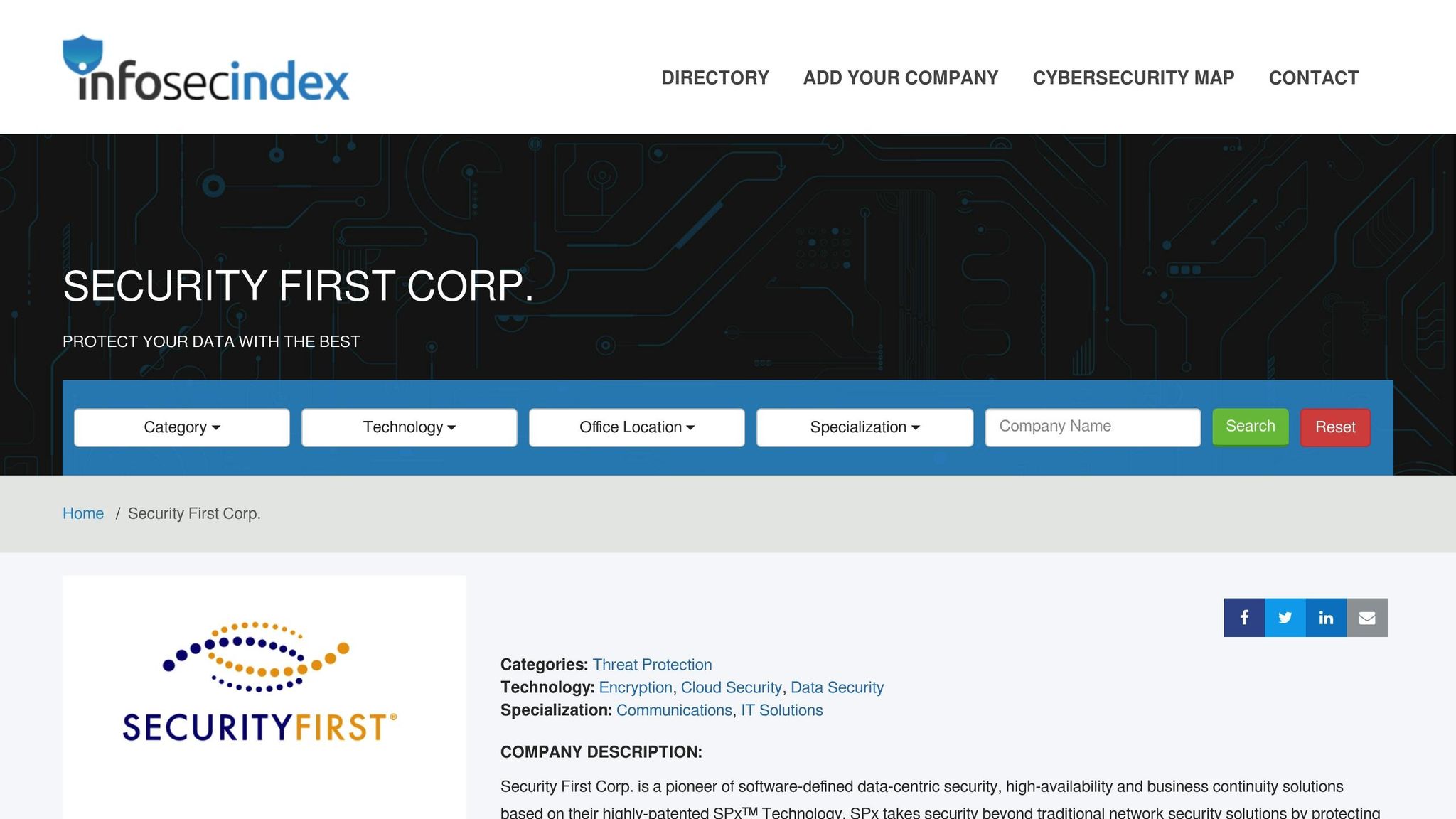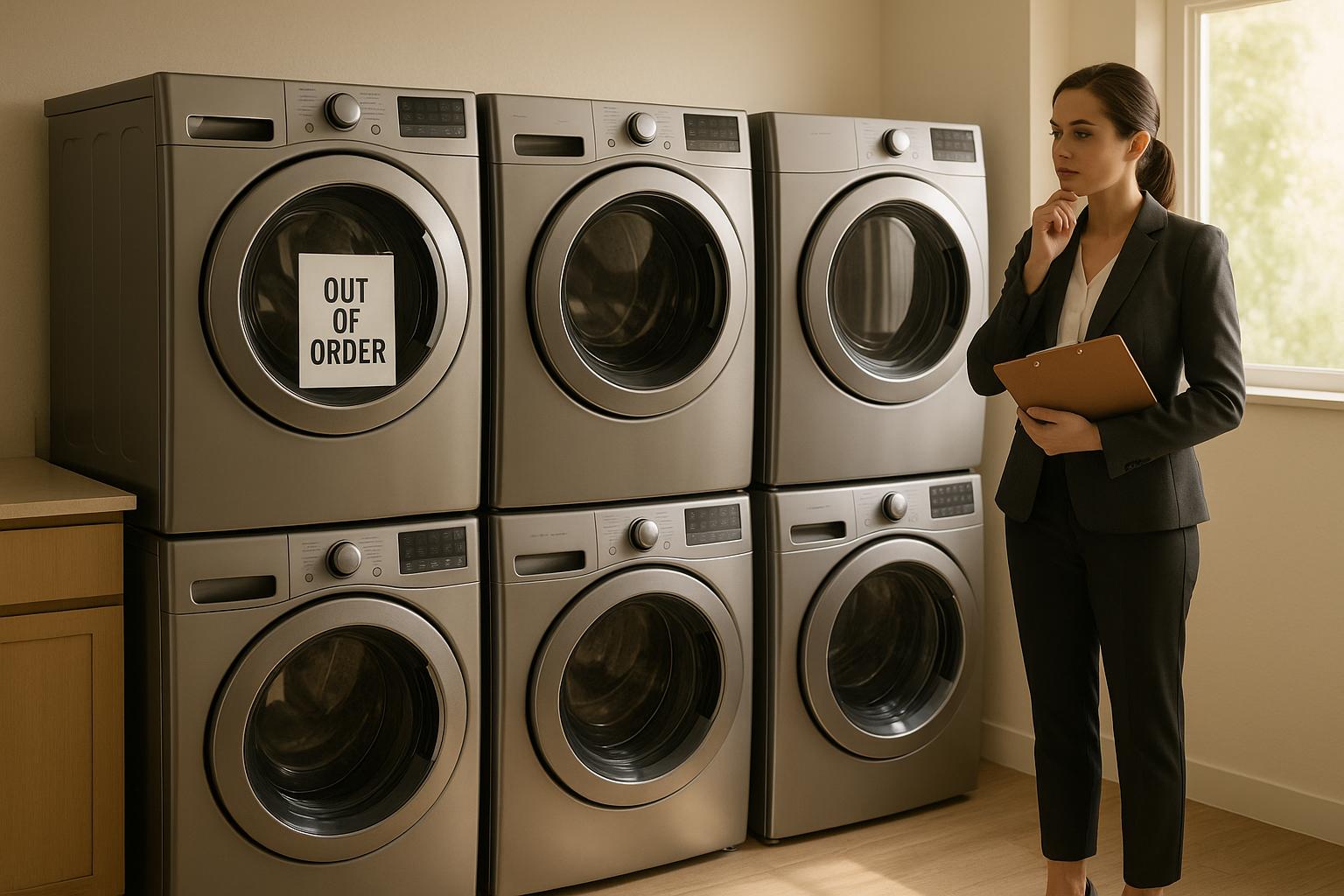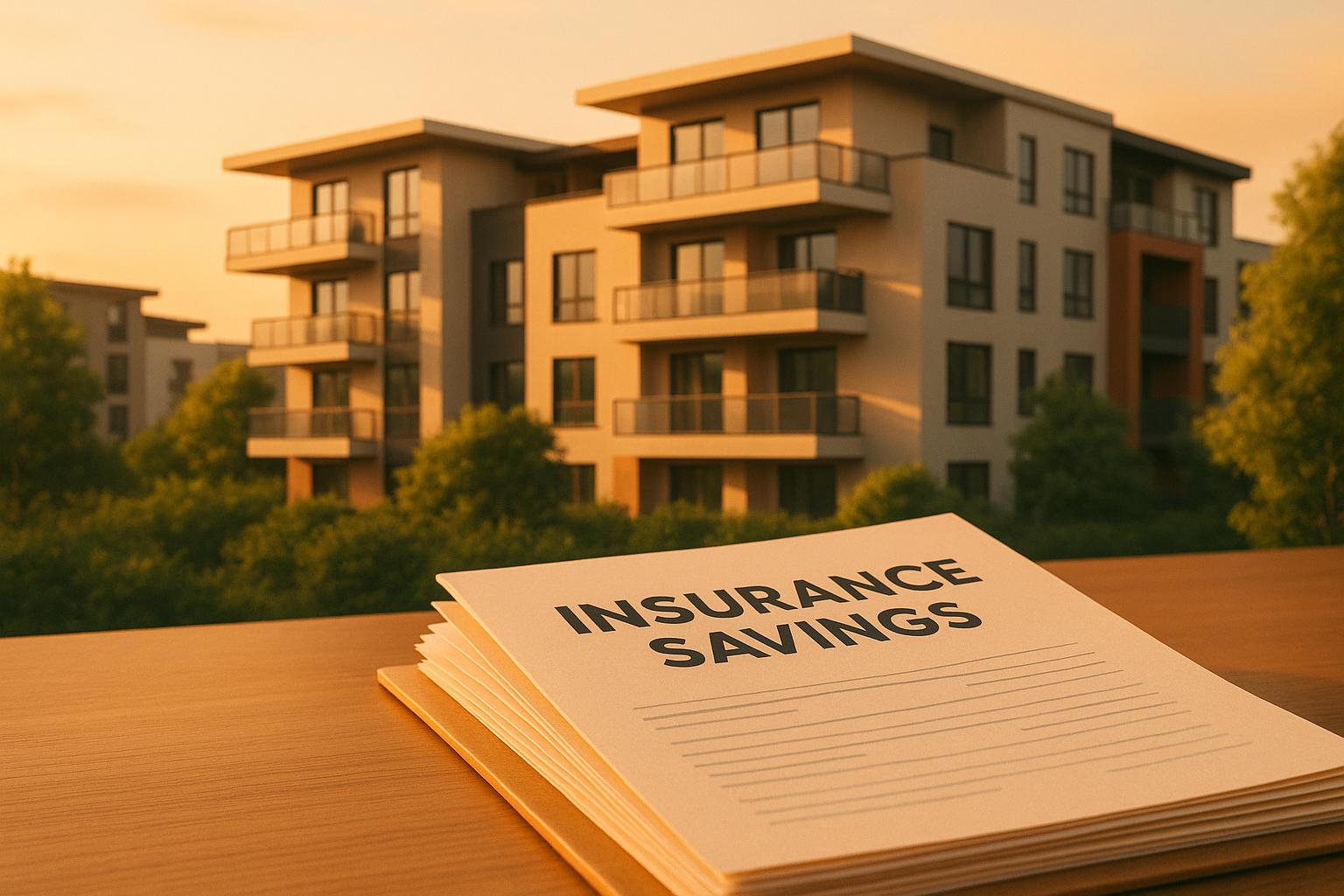Smart locks are transforming multifamily housing by replacing physical keys with digital access methods like PIN codes, mobile apps, and biometrics. These systems improve security, simplify property management, and enhance the resident experience. Here’s why they matter:
- Tenant Demand: 67% of renters prefer keyless locks, and 65% are willing to pay extra for smart amenities.
- Cost Savings: Smart locks eliminate rekeying costs ($50–$100 per unit) and reduce maintenance time by up to 50%.
- Efficiency: Property managers report a 20% boost in efficiency and 18% lower operating costs.
- Security: Smart locks prevent key copying, track access, and integrate with cameras and alarms.
Popular options include keypad locks (affordable), mobile app-enabled locks (mid-range), key card systems (secure), and biometric locks (high-end). These systems cater to properties of all sizes, offering convenience for tenants and operational ease for managers. Smart locks are quickly becoming a must-have feature in the competitive rental market.
Can Smart Lock Systems Be Used For Apartments? - SecurityFirstCorp.com

Types of Smart Locks in Multifamily Housing
Choosing the right smart lock for a multifamily property means understanding the various options available. Each type comes with its own features, price range, and benefits, making it easier for property managers to match the solution to their specific needs. Below, we explore the main types of smart locks commonly used in multifamily housing.
Keypad and PIN Code Locks
Keypad locks use numeric codes entered on a digital pad to grant access, eliminating the need for physical keys. This makes them a budget-friendly option for properties. Residents are assigned individual codes, and property managers can quickly update or revoke access as needed.
These systems are priced between $500 and $2,500 per door[9], making them one of the most economical choices. However, they do come with some security concerns - codes can be shared or observed by others. To address this, keypad locks are often paired with additional security measures[10].
Despite these limitations, keypad locks offer practical advantages. For instance, three out of four multifamily property managers consider the reduced cost of replacing keys a major benefit of smart locks[11]. Additionally, 73% of multifamily properties equipped with smart locks use them to grant remote access for purposes like unaccompanied showings, package deliveries, or third-party services[11].
Mobile App-Enabled Locks
Mobile app-enabled locks take convenience to the next level by allowing residents to unlock doors using their smartphones or QR codes. These systems eliminate the hassle of physical keys or memorized codes. Property managers can issue digital credentials directly to residents' phones and manage access remotely through centralized platforms.
With prices ranging from $1,000 to $2,500 per door[9], these locks fall into the mid-range category. The cost reflects their advanced features, such as real-time notifications, temporary access codes, and integration with property management software.
Mobile credentials also improve security. Unlike key cards, phones are less likely to be lost, reducing replacement costs and minimizing security risks[10]. Plus, the convenience factor is hard to beat - residents are far less likely to lock themselves out when their phone doubles as their key.
Key Card and Fob Access Systems
Key card and fob systems are another reliable option for multifamily properties. Residents simply tap or wave their card or fob near a reader to gain entry. These systems also provide property managers with detailed access logs, making it easy to track who entered and when.
The cost for these systems ranges from $1,500 to $3,500 per door[9]. While they’re more expensive than keypad locks, their tracking capabilities and reduced vulnerability to shared PIN codes make them a strong choice for many properties.
However, lost or stolen cards remain a challenge. Property managers need to stay on top of deactivating misplaced cards to prevent unauthorized access[12].
Biometric Locks
Biometric locks represent the high-end option for smart lock technology. These systems use fingerprints, facial recognition, or iris scanning to verify identity, offering unmatched security. Since biometric data can’t be easily shared, stolen, or duplicated, these locks are ideal for areas requiring maximum protection.
The pricing reflects their sophistication. Biometric locks range from $1,500 to $8,000+ per door[9]. Fingerprint scanners are the most affordable, costing $1,500 to $3,000 per door, while facial recognition systems fall between $2,500 and $5,000 per door. Iris scanning systems sit at the top tier, costing $5,000 to $8,000+ per door[9].
"Interest and adoption of electronic locks have been strong over the last five years and get stronger each year." - Bobby Welliver, AVP, Multifamily Housing Solutions, dormakaba[11]
While these systems are often too advanced for standard residential units, they are increasingly popular in high-security areas like server rooms, management offices, or exclusive amenity spaces.
Combining Technologies for Multifamily Properties
Most multifamily properties use a mix of these technologies to meet their security needs. For example, keypad locks might be installed at basic access points, mobile app-enabled locks for resident units, and biometric systems for high-security areas. This tailored approach ensures that each part of the property has the right level of security without overspending.
Why Property Managers and Owners Are Making the Switch
Property managers and owners are facing a trifecta of challenges: rising costs, security vulnerabilities, and increasing pressure to meet modern resident expectations. Traditional lock-and-key systems are no longer cutting it, while smart locks offer a streamlined, tech-forward solution to these problems.
Problems with Lock-and-Key Systems
Lost keys, stolen keys, and constant rekeying have become a logistical and financial headache for property managers, particularly in large complexes[17][18]. Traditional keys are not just inconvenient - they’re a security risk. They can be copied or misplaced, leaving properties open to unauthorized access[1]. This is especially alarming given that multifamily apartments are 85% more likely to be burglarized than single-family homes[14].
"The traditional metal key, once the cornerstone of security, is now a glaring vulnerability. The ease with which these keys can be duplicated poses a significant risk." - SALTO Systems[18]
For properties with hundreds of units, managing key handoffs for maintenance or replacing lost keys becomes a constant drain on time and resources. Despite these challenges, 30–40% of U.S. apartment buildings still use physical keys for unit doors[6]. This outdated system not only creates inefficiencies but also leaves properties exposed to unnecessary risks - both operational and security-related.
Demand for Digital-First Amenities
Today’s renters aren’t just open to smart locks - they expect them. 67% of renters want keyless smart locks in their homes[5]. And this isn’t just a fleeting trend. The smart home tech industry was valued at over $79 billion last year and is projected to soar past $537 billion by 2030[21].
The numbers speak volumes: 84% of renters without smart home technology say they want it in their communities[21]. More than half of renters would even pay 1-10% more in rent for property technology, and nearly 30% would pay at least 11% more[23]. Security is a major driver too - 57% of renters are willing to pay extra for enhanced security features[19].
"Smart locks have emerged as a critical technology for apartment buildings and multi-family housing. The security and convenience enhancements benefit tenants, property managers, and owners." - INOX Smart[20]
Properties that don’t offer these digital amenities risk falling behind. Smart locks are quickly becoming a key differentiator in the competitive multifamily housing market[5]. Owners who fail to adapt risk losing tenants to properties that embrace modern conveniences.
Efficiency and Cost Savings
Smart locks don’t just solve security issues - they also simplify day-to-day operations. They automate access for new residents, vendors, and staff[3], eliminating the hassle of physical key exchanges.
Move-ins and move-outs become seamless with remote access capabilities. Property managers can grant temporary codes to maintenance teams, revoke access instantly, and focus on higher-priority tasks like tenant satisfaction and property upgrades. This reduces staff workload and improves overall efficiency.
Smart locks also help prevent costly issues. For example, maintenance teams can respond faster to problems like water leaks in vacant units without needing to track down physical keys[3]. Additionally, properties can use smart locks to enable secure self-guided tours, saving staff time while offering convenience to prospective residents. Integration with platforms like Power Pro Leasing and Pynwheel even automates scheduling and identity verification for these tours[6].
"Smart locks aren't just about eliminating security risks - they're about streamlining operations and delivering a better experience for residents and property managers alike." - RemoteLock[6]
Beyond operational improvements, smart locks enhance property value by modernizing the community’s image. As Kristen Hanich, Research Director at Parks Associates, explains: "Multifamily properties are increasingly adopting access control technology to ensure that only authorized persons can enter the property"[22].
Benefits of Smart Locks for Multifamily Properties
Smart locks offer more than just a high-tech alternative to traditional keys. They reshape property management, boost security, and make life easier for both property managers and residents. Here's a quick side-by-side comparison of how smart locks stack up against traditional lock-and-key systems:
| Feature | Traditional Locks | Smart Locks |
|---|---|---|
| Security | Prone to picking, bumping, and key duplication | Encrypted access, tamper alerts, and detailed audit trails |
| Access Management | Requires physical key exchanges | Remote access granting and revoking |
| Turnover Costs | $50–$100 per unit for rekeying | No rekeying costs - credentials updated digitally |
| Maintenance Time | Staff involvement at $20/hour for key issues | Minimal staff time with remote management |
| Access Tracking | No entry/exit records | Comprehensive audit trail with timestamps |
This table underscores how smart locks outperform traditional locks in nearly every category. Let’s take a closer look at these benefits.
Better Security Through Digital Access
Smart locks address the weak points of traditional keyed systems. Unlike physical keys that can be copied at any hardware store, smart locks utilize encryption and authentication protocols, making unauthorized duplication nearly impossible [6]. They’re also designed to resist tampering methods like picking, bumping, or drilling. Plus, they notify property managers of any tampering or forced entry attempts [2].
For added security, smart locks integrate seamlessly with other systems, such as surveillance cameras and alarms, creating a more comprehensive approach to property protection [26].
Remote Management and Monitoring
One standout feature of smart locks is their ability to enable remote access management. Property managers no longer need to be physically present to grant access for maintenance, deliveries, or new tenants. With features like temporary codes and mobile credentials, smart locks provide a level of flexibility that traditional keys can’t match [6][27].
Additionally, smart locks can integrate with property management software to automate tasks like code generation, lease updates, and maintenance scheduling. For example, when a resident moves out, access permissions update automatically, reducing manual intervention [27]. Real-time monitoring and detailed access logs further enhance accountability and minimize unauthorized access risks [27].
Easier Turnover Processes
Turnovers are much simpler with smart locks. Traditional systems require rekeying, which can cost $50 or more per unit. Smart locks eliminate this expense by allowing credentials to be updated digitally [29].
For example, RedPeak, an apartment management company, implemented RemoteLock's universal access control system across 900 units in 15 buildings. This integration, combined with Yardi Voyager software, reduced maintenance and rekeying time by up to 50%, leading to faster turnovers and shorter vacancy periods [19][29]. The automated system allowed over 60 employees to manage access remotely, cutting down on time and resources while improving security [29].
Better Resident Experience
For residents, smart locks offer unmatched convenience. They no longer have to juggle keys when their hands are full, worry about losing them, or deal with being locked out. Smart locks also make it easy to grant temporary access to guests, delivery drivers, or service providers, even when residents aren’t home.
These locks can also integrate with other smart home devices, creating a connected living experience. A survey found that 52% of U.S. consumers are willing to invest in smart home technology because they value the ability to control their homes remotely [25].
Additionally, smart locks can increase property value. Many residents are willing to pay an extra $20–$35 per month for properties with smart amenities, and some properties have reported rental rate increases of up to $37.65 per unit [28][31]. Beyond financial benefits, properties with smart locks see about 10% fewer maintenance requests, further easing the workload for property managers [30].
"Smart locks are more than just buzzword technologies, they represent a practical, scalable and transformational solution for modern property management systems." - RentalReady [27]
sbb-itb-58157f8
Popular Smart Lock Brands for Multifamily Properties
Smart locks have become a cornerstone for improving both operations and security in multifamily properties. But when managing large portfolios, it's essential to choose brands that can handle the scale and integrate seamlessly with your property management systems. The right choice ensures smooth operations, satisfied residents, and efficient management of hundreds - or even thousands - of units.
Features That Matter for Multifamily Deployment
When evaluating smart lock brands for multifamily properties, focus on a few key features:
- Scalability: The system should work just as effectively for 50 units as it does for 50,000, without adding unnecessary strain on your team or budget [5].
- Versatile Credential Options: Look for solutions that offer mobile app access, PIN codes, and master key capabilities to cater to a variety of user preferences. Flexible permission levels are also a must for managing different types of users [32].
- Integration Capabilities: Robust integration with property management systems simplifies tasks like credential management, move-ins, and maintenance. Many brands even offer custom integrations for portfolio-wide solutions [5].
- Durability and Reliability: Features like weather resistance, long battery life, low battery alerts, and backup power options are essential for ensuring uninterrupted service [5].
- Audit Trails and Activity Logs: These provide detailed access records, which are invaluable for security, maintenance, and addressing resident concerns [5].
Several brands have developed products specifically designed to meet the unique challenges of multifamily properties, offering solutions that check all these boxes.
Examples of Popular Brands
Here’s a look at some standout smart lock brands and what they bring to the table for multifamily deployments:
SmartRent
SmartRent offers a comprehensive platform tailored for multifamily properties, featuring resident app integration, PIN code access, and even Apple Wallet unlock functionality. With Z-Wave connectivity, their locks integrate seamlessly with smart home ecosystems like Apple HomeKit, Google Assistant, and Amazon Alexa.
Schlage Control
Schlage leverages its decades of expertise in lock manufacturing with its smart lock solutions. Their locks work with Engage Software, a cloud-based platform designed for multifamily properties, enabling mobile access via Bluetooth and remote credential management [15][16].
Yale Assure Lock SL
Yale’s Assure Lock SL stands out for its versatility, offering both keypad and app-based unlocking. It supports multiple connection types, including Bluetooth Low Energy (BLE), Z-Wave Plus, and Zigbee. Additionally, its built-in door position sensor enhances security monitoring.
Sifely Smart Locks
Sifely provides seamless integration with property management systems through its open API. Their centralized portal simplifies lock management across communities, making it easier to oversee large portfolios [5]. Other notable options include dormakaba Saffire and additional models from Schlage and Yale, allowing property managers to select solutions that best fit their needs [15].
| Smart Lock Brand | Key Features | Connection Type | Integration |
|---|---|---|---|
| SmartRent | Resident App, PIN code, Apple Wallet unlock | Z-Wave | Apple HomeKit, Google Assistant, Amazon Alexa |
| Schlage Control | Smartphone app, PIN code, metal keys unlock | WiFi | Integrated with Engage Software, Alexa, Google |
| Yale Assure Lock SL | Keypad or app unlock | BLE, Z-Wave Plus, Zigbee | Includes door position sensor |
Each of these brands brings unique strengths to the multifamily market, making it easier for property managers to find the right fit for their specific operational needs.
Market Trends Driving Smart Lock Adoption
The growing adoption of smart lock technology in multifamily properties isn't just about convenience or security anymore. It's also being driven by broader market trends that highlight the importance of tech-enabled solutions for attracting and retaining residents. These trends are reshaping what renters expect and how property managers operate.
Rising Demand for Tech-Enabled Amenities
Today's renters have a different set of priorities. Traditional amenities like pools and gyms are no longer at the top of their wishlists. Instead, tech-enabled conveniences are taking center stage. In fact, 58% of renters would trade amenities like pools and gyms for smart tech if it meant lower rent[4]. This isn't just a passing preference - 65% of renters are drawn to apartments with smart home technology, and 54% now expect features like smart locks, thermostats, and security cameras in modern rental properties[4]. What was once considered a luxury is now the baseline.
"We're witnessing a real shift in what renters consider essential. Smart home technology is no longer a nice-to-have. It's a baseline expectation."
The financial benefits for property owners are clear, too. Sixty-five percent of renters are willing to pay extra for smart amenities, with 52% comfortable paying over $20 more per month[4]. When it comes to smart locks specifically, 67% of renters prefer keyless smart locks[5][24]. Reflecting this demand, 85% of new multifamily developments now include smart locks, and 60% of existing properties plan to upgrade[24].
"Expectations for smart locks and electronic access control intensify as each generation becomes more tech-savvy."
These shifting preferences highlight the growing importance of advanced security measures, which are explored further below.
Security and Compliance Pressures
Security remains a top concern for renters and property managers alike. Multifamily apartments face an 85% higher risk of burglary, and 41% of renters rank enhanced security as their top priority[14][4]. Unlike traditional locks, which can be vulnerable to key duplication and tampering, smart locks use encryption and authentication to prevent unauthorized access[7].
"Smart locks offer a level of convenience and security that traditional locks just can't match. They let residents unlock their doors remotely, provide temporary access codes for guests, and even track who's coming and going. For multi-family housing, this added layer of control is a game-changer."
- Jane Drake, Marketing Coordinator at Level Home[33]
Smart locks also provide detailed access logs, which can help resolve disputes and aid in security investigations. On top of that, compliance with safety standards is crucial. Smart locks must meet the same fire safety requirements as other building materials, ensuring they integrate seamlessly with existing security systems while meeting regulatory demands[32].
These security and compliance benefits align perfectly with the growing trend of remote property management.
Growth of Remote Property Management
The rise of remote property management is another key factor accelerating the adoption of smart locks. Managing hundreds or even thousands of units remotely requires systems that simplify operations. Properties equipped with smart locks and electronic access control systems report 10% fewer maintenance requests and save an average of $80,000 per year, per building[30].
These savings come from several operational improvements. Remote access capabilities eliminate the need for physical key handovers during tenant turnovers, freeing up staff time. Maintenance teams can access units more efficiently for repairs, and property managers can grant temporary access to contractors, delivery drivers, or prospective tenants - all without being on-site.
Smart locks also enable self-guided tours, giving prospective renters the flexibility to view properties on their own schedule. At the same time, property managers can monitor access activity, identify potential security issues, and respond to resident needs from anywhere. When integrated with property management software, smart locks can automate access permissions based on lease agreements and move-in schedules, reducing administrative tasks while improving accuracy and security.
Conclusion
Smart locks have transitioned from being a high-end feature to a must-have investment for multifamily properties. With properties equipped with smart technology seeing a return on investment (ROI) of 5% to 6% [34], these systems are redefining property management. For managers grappling with key management headaches, security challenges, and operational inefficiencies, smart locks provide a practical, results-driven solution.
Take rekeying costs, for example - smart locks can save over $3,000 annually for a property with 50 doors while cutting maintenance time by up to 50% [19]. This not only saves money but also frees up valuable resources. Remote access management further streamlines operations, delivering fast ROI and making everyday tasks more efficient.
"Smart locks are not just an upgrade - they're an investment in security, efficiency, and user experience. By reducing operational costs and enhancing convenience, they quickly pay for themselves." - RemoteLock [29]
The security benefits are equally compelling. By eliminating risks tied to lost, copied, or stolen keys, smart locks address a critical vulnerability. With nearly 7 million property crimes reported annually in the U.S. - 34% involving entry through a front door with a compromised lock or key [29] - digital access control offers a much-needed safeguard. Features like detailed access logs and real-time monitoring add another layer of protection.
But it’s not just about cost and security - smart locks dramatically enhance the resident experience. Properties with smart technology see a 60% higher likelihood of lease renewals [19], and 86% of millennials are willing to pay up to 20% more for a smart apartment [34]. Keyless entry, remote access control, and activity tracking make life easier for residents while boosting a property's appeal [13].
For multifamily property owners and managers aiming to stay competitive, smart locks are more than a tech upgrade - they’re a forward-thinking investment. Combining better security, operational savings, and improved resident satisfaction, smart locks have become a cornerstone of modern property management.
FAQs
How do smart locks improve security in large multifamily properties?
Smart locks bring a modern edge to security in multifamily properties, tackling the weaknesses of traditional keys - like getting lost, stolen, or copied without permission. Unlike old-school locks, these devices let property managers grant or revoke access instantly, cutting down on the chances of someone entering without authorization.
What’s more, smart locks come packed with useful features such as remote access control, real-time activity monitoring, and detailed audit trails. These tools give property managers a clearer view of who’s coming and going, making security management much more efficient. With their resistance to tampering and the ability to address issues quickly, smart locks have become a dependable choice for protecting large multifamily communities.
What are the costs of installing smart locks in a multifamily property, and how can they help reduce operating expenses?
Installing smart locks in multifamily properties might require an initial investment, but the long-term savings can be substantial. One of the biggest advantages? No more rekeying. For instance, a property with 50 units could save over $3,000 annually by cutting out rekeying costs alone.
Beyond cost savings, smart locks can significantly reduce maintenance requests. Some properties have reported up to a 50% drop in service calls related to locks. This not only slashes operational costs but also streamlines property management tasks and boosts the overall experience for residents. Over time, these benefits make smart locks a practical and efficient choice for multifamily housing.
How do smart locks work with property management systems to boost efficiency and enhance the resident experience?
Smart locks connect with property management systems (PMS) through technologies like Wi-Fi, Bluetooth, or dedicated access control platforms. This connection gives property managers the ability to manage access remotely, track lock activity, and automate various tasks. Features such as real-time access control and detailed audit logs boost security while making daily operations smoother.
For residents, smart locks bring added convenience by offering keyless entry and quicker solutions to access problems. Property managers, on the other hand, enjoy easier tenant turnover since locks can be updated or reprogrammed remotely - no need to deal with physical keys. This not only saves time but also ensures a smoother experience for both managers and tenants.


